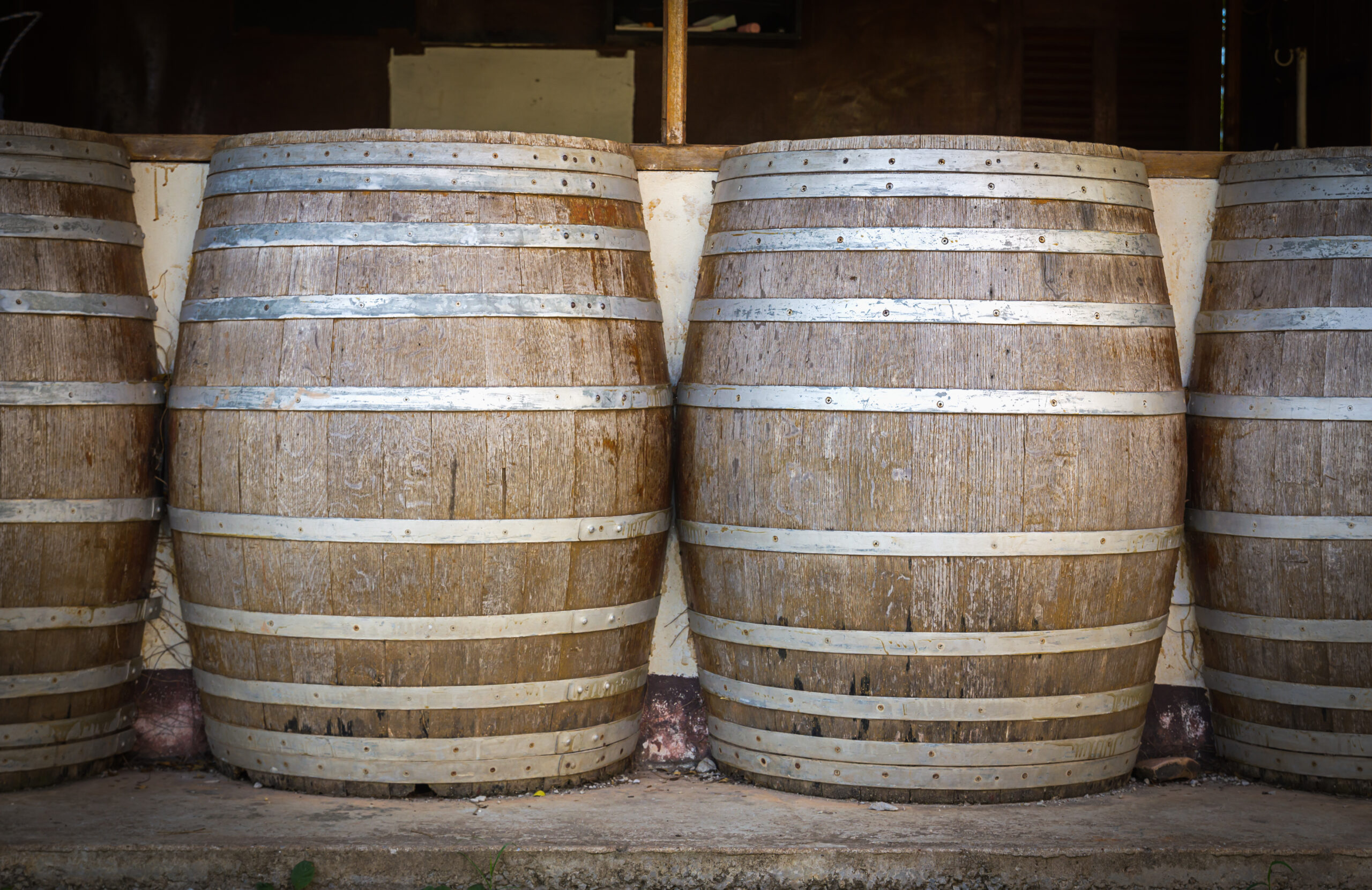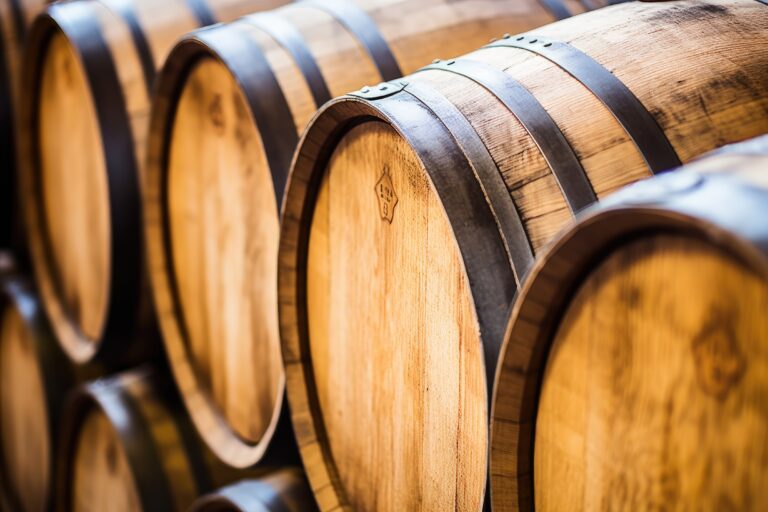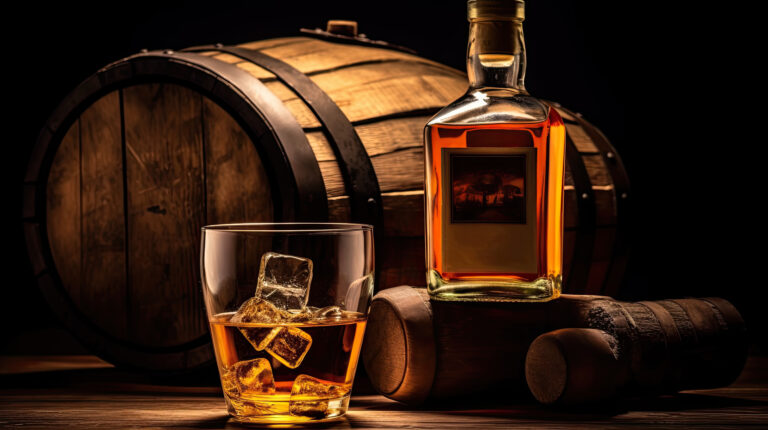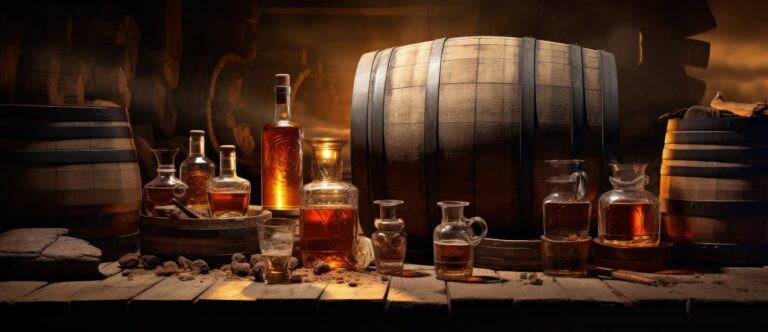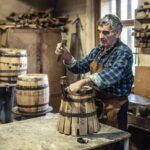Ever wondered why those gorgeous whiskey barrels lounging in rickhouses come in all sorts of shapes and sizes? As a fellow whiskey enthusiast, you’ve probably noticed the variety of barrel heights different distillers and brands use. It’s not just for show! The size of a whiskey barrel, particularly its height, dramatically impacts the flavor and aroma compounds that develop as the spirit matures. Shorter, squatter casks tend to yield whiskey with more intense, wood-derived notes like vanilla, caramel, and spice. On the flip side, taller, thinner barrels typically give you a lighter, fruitier spirit with delicate floral aromatics.
The Wonderful World of Whiskey Barrels
When you dive into the world of whiskey barrels, you’ll quickly realize they come in a fascinating array of dimensions. While some distillers get creative with custom sizes, there are three standard barrel heights you should definitely know about:
- The most common is the bourbon barrel, clocking in at around 53 gallons or 200 liters. These beauties are renowned for producing a robust, caramel-rich flavor profile.
- For a lighter, fruitier touch, distillers often reach for hogshead barrels. These larger casks hold approximately 66 gallons or 250 liters.
- The smallest standard barrel is the quarter cask, which holds about 22 gallons or 83 liters. Whiskeys aged in these mini-casks develop intense wood flavors in a surprisingly short amount of time.
Ultimately, the choice of barrel height boils down to the specific flavor profile the distiller is aiming for. Think of it this way: smaller barrels mean more wood exposure for the whiskey, leading to deeper, spicier notes. Conversely, larger barrels tend to produce lighter, sweeter tones. Now you’ve got the basics for navigating this intriguing sea of whiskey barrel heights. The only question left is, how do you like your whiskey?
Standard Barrel Sizes in Whiskey Aging
Standard barrel sizes are crucial for maintaining consistency in the whiskey aging process. Here are some of the most common dimensions you’ll encounter:
- 53 gallons: This is the most popular size, widely used for aging bourbon and Scotch whisky.
- 63 gallons: You’ll often find these barrels employed for rye whiskeys and Canadian whiskies.
- 59 gallons: This size is a common sight in Ireland for aging delicious Irish whiskey.
The specific barrel size a distiller chooses largely depends on the particular whiskey they want to produce. This size directly impacts how much of the barrel’s wood flavors and aromas are imparted to the spirit during aging. More surface area in a smaller barrel means faster aging, while less surface area in a larger barrel leads to a slower maturation process.
Many distillers even experiment with a variety of barrel sizes to craft unique flavor profiles by blending whiskeys aged in different sized casks. This experimentation often results in special edition or limited release whiskeys with truly distinctive tastes. So, the next time you savor a new whiskey, take a moment to consider how its unique flavor might have been influenced, in part, by the size of the barrels used to age this complex and captivating spirit. The relationship between barrel size and taste is genuinely an art form in the hands of a skilled distiller.
The Story Behind the Standard 53-Gallon Barrel
The standard 53-gallon whiskey barrel has been a staple for centuries, but have you ever wondered why that specific size? This dimension really took off in the early 1700s, and there were a few clever reasons behind it:
- Ease of Transportation: These barrels needed to be small enough for folks to move by hand, yet large enough to hold a good volume of whiskey. At 53 gallons, a barrel was perfectly sized to be rolled and transported, while still containing a substantial amount of aged whiskey. This size was ideal for manually loading barrels onto wagons and boats for shipping.
- Oak Abundance: Back then, oak trees big enough to craft 53-gallon barrels were plentiful, especially white oak. White oak boasts tight wood grains that are less prone to leaking liquid, making it perfect for aging spirits. The 53-gallon size was simply efficient to produce from the readily available oak timber of the time.
- Tax Savvy: In England, a barrel of beer held 36 gallons, while a barrel of wine held 32 gallons. Whiskey distillers in Scotland, ever the clever bunch, wanted their own standard. So, they settled on 53 gallons. This “odd” size differentiated from the established beer and wine standards, allowing distillers to potentially pay lower taxes since whiskey was taxed by the barrel. The 53-gallon barrel size stuck and became the norm for aging and shipping whiskey.
So there you have it – a perfect blend of practicality, material availability, and a touch of tax evasion gave us the standard 53-gallon whiskey barrel that’s still used today. Whiskey lovers around the globe can raise a glass to this ideal barrel size that made whiskey production and distribution possible at scale.
Why Whiskey Barrel Height is a Game-Changer for Aging
The height of a whiskey barrel isn’t just a design choice; it plays a critical role in the aging process.
- Shorter barrels, like those favored for bourbon, expose more of the whiskey’s surface area to the charred wood. This means the whiskey absorbs more flavor and color in a shorter period, leading to a more intense, wood-forward profile.
- Taller barrels, often used for Scotch whisky, have a lower surface area to volume ratio. This translates to the whiskey interacting with the wood more slowly. This leisurely aging process results in more subtle flavors and lighter colors.
The specific wood used for the barrels also profoundly impacts aging. Barrels crafted from American oak, commonly used for bourbon, impart sweeter flavors like vanilla. Meanwhile, barrels made from French oak, often employed for Scotch, tend to impart spicier flavors.
Ultimately, barrel height is a matter of personal taste and how quickly a distiller wants to age their whiskey. Both shorter and taller barrels can produce truly exceptional whiskeys. But when it comes to aging, size really does matter.
How Barrel Size Shapes Whiskey Flavor
The size of a whiskey barrel has a direct, undeniable impact on the flavor of the final product.
- Larger barrels, like those traditionally used for bourbon, expose more of the whiskey’s surface area to oxygen, which actually causes it to age faster. This increased oxidation results in a lighter, sweeter flavor profile.
- Smaller barrels, often the choice for Scotch whisky, age the spirit more slowly. Less surface area means less oxidation and a more deliberate maturation process. This typically produces a whiskey with a more robust, intense flavor.
Here’s the key takeaway: the smaller the barrel, the more concentrated the flavor. In a smaller cask, the wood-to-whiskey ratio is higher. This means more wood sugars and wood tannins seep into the spirit, giving Scotch from smaller barrels a distinctive smoky, spicy character.
Bourbon, on the other hand, truly benefits from larger barrels where the whiskey is exposed to greater airflow. The additional oxygenation encourages faster aging and results in a lighter, smoother taste with inviting notes of vanilla and caramel. The larger barrels also allow some of the harsher compounds to mellow and fade away, creating an altogether softer, sweeter flavor profile.
Whether large or small, barrel size exerts an enormous influence over a whiskey’s final flavor. Subtle differences in oxidation and wood contact impart distinctive characteristics that shape a whiskey’s taste, aroma, color, and mouthfeel. Barrel size is undeniably a key factor distinguishing the varied flavors of the world’s greatest whiskies.
Playing Around with Non-Standard Barrel Sizes
Stepping outside the typical barrel size range can lead to some incredibly interesting flavor experiments. Some distilleries have started aging their whiskey in extra-large barrels, sometimes called “hogsheads.” The greater surface area allows for more oxidation and evaporation, which can result in a lighter, fruitier flavor profile.
On the flip side, using smaller barrels, known as “quarter casks” or “octaves,” significantly speeds up the aging process. The smaller volume means the whiskey has more contact with the wood, absorbing flavor compounds at an accelerated rate. After just a few years, a whiskey aged in small barrels can take on rich notes of vanilla, spice, and caramel. However, a word of caution: it can become over-oaked if left for too long.
A few adventurous distilleries have even experimented with barrel shapes beyond the classic rounded profile. Square or rectangular barrels provide more surface area for the whiskey to interact with the wood. Some claim this can lead to more complex flavors in a shorter period. Conical barrels, with wider tops and narrower bottoms, are said to allow for greater oxidation and more flavor exchange between the wood and spirit.
While these non-standard barrels show promise for creating unique flavor profiles, they do come with some trade-offs. Unusual shapes and sizes can be more difficult and expensive to produce and may lead to higher rates of evaporation. But for craft distillers looking to truly stand out in a sea of bourbons and ryes, experimenting with barrel variations could be a risk worth taking.
The Lowdown on Small Barrels: Pros and Cons
The size of a whiskey barrel plays a significant role in determining the flavor and aroma compounds that develop during the aging process. Small barrels, typically ranging from 5 to 15 gallons, come with their own set of advantages and disadvantages compared to the standard 53-gallon barrels.
Pros
- Faster Aging: Small barrels age whiskey at an accelerated pace due to their higher surface area to volume ratio. This means the whiskey can extract more flavor from the wood in less time.
- Robust Flavors: Whiskey aged in small barrels often develops a robust, oaky flavor in just 6-24 months. This shorter aging time means distilleries can release products sooner, catering to eager whiskey enthusiasts.
Cons
- Over-Oaking Risk: The rapid aging in small barrels can lead to over-oaking, where the wood flavors become too dominant. The whiskey might develop an unpleasant bitterness, impacting its overall taste profile.
- Lower Yield: Small barrels simply produce less whiskey. To age the same volume as a standard barrel, many more small barrels are needed, which requires more storage space and resources.
- Higher Cost: Small barrel whiskey tends to cost more due to the additional expense of using a greater number of barrels. Consumers often pay a premium for these intensified flavors.
- Flavor Variability: There’s generally more variability in flavor between small barrels, even when using the same type of wood and char level. Achieving consistency across batches can be quite challenging.
Despite these disadvantages, many craft distilleries and even some larger ones leverage small barrels to produce unique, experimental whiskies with powerful, wood-forward flavors. When executed skillfully, small barrel aging can create truly memorable whiskies that beautifully showcase the influence of wood. But, like many good things, moderation is key!
The Cutting Edge: Innovations in Custom Barrel Design
In recent years, custom barrel makers have truly pushed the boundaries, introducing innovative designs to produce incredibly unique flavors and aromas in spirits.
Barrel Alternatives
Coopers (barrel makers) are now experimenting with different wood types, like maple or acacia, as alternatives to traditional oak. These can impart distinct taste profiles to the spirit. Some adventurous distillers have even ventured into using barrels made from exotic woods like mango or teak.
Unique Toasts and Char Levels
The level of “toast” – how much the inside of the barrel is charred – also significantly affects flavor. Distillers can now request light, medium, or heavy toasts, or even customize multi-level toasts, with different intensities on the barrel head, staves, and chime. This allows for incredible precision in flavor development.
Unusual Shapes
Who says barrels have to be the standard bulky, round shape? Different forms like oval, square, or multi-angled barrels expose the spirit to wood in entirely new ways. The shape directly impacts how much surface area is in contact with the spirit, influencing how quickly it picks up characteristics from the wood.
Double Barrels and Finishing
Some distillers are mastering the art of double barreling or finishing, by further aging spirits in used barrels that previously held different types of drinks like rum, wine, or port. This process exposes the spirit to two distinct sets of flavors that mingle together in fascinating and unusual ways. The possibilities for innovation are truly endless!
Distillers now have more options than ever to craft custom spirits with truly unique tastes. By getting creative with barrel designs, types of wood, and toasting levels, makers can produce whiskies as distinctive as their brand. The future of barrel-aged spirits looks incredibly bright with all these exciting new horizons to explore.
FAQ: Your Burning Questions About Barrel Size, Answered!
How big are whiskey barrels?
Whiskey barrels come in a range of sizes, typically from 5 to over 60 gallons. The most common sizes you’ll encounter are the standard barrel (53 gallons) and the smaller quarter cask (10-15 gallons).
Why are there different barrel sizes?
Barrel size directly affects how quickly the whiskey ages and picks up flavors from the wood. Smaller barrels mean more surface area contact between the whiskey and wood, so the whiskey ages faster. Bigger barrels take longer to impart flavor, but often produce smoother, more mellow results. Distilleries choose sizes based on their specific aging goals and desired flavor profiles.
How does barrel size affect taste?
Whiskey aged in smaller barrels picks up wood flavors more quickly, often resulting in bolder, spicier tastes with rich notes of vanilla, caramel, and oak. Larger barrels typically produce mellower, smoother flavors. Many distilleries skillfully use a combination of sizes to create complex, layered flavors in their whiskeys.
Why are most barrels made of oak?
Oak is truly ideal for aging whiskey. Its unique pores allow tiny amounts of oxygen to gently enter and exit the barrel, helping to mellow and refine the whiskey. Oak also contains beneficial compounds like lactones and phenols that impart delicious flavors and aromas as the whiskey interacts with the wood. Plus, oak sourced from different locations like America, Spain, and France each contribute distinct flavor profiles to the spirit.
Ultimately, barrel size and oak type come together in a beautiful dance to create a whiskey’s distinctive taste. Experimenting with different barrels is truly part of the art of distillation.
Final Thoughts on the Magic of Whiskey Barrels
So, there you have it – a quick dive into why whiskey barrel heights are far more important than you might think, and how they profoundly impact the flavor of your favorite bourbon or Scotch. The next time you order a glass of barrel-aged whiskey, take a moment to consider how the height, char level, and even the specific wood of the barrel it aged in helped craft the delightful taste you’re enjoying.
It’s pretty incredible how such seemingly small details can make such a huge difference, isn’t it? But that’s the essence of true craftsmanship and expertise for you. Distillers leave absolutely nothing to chance when it comes to producing a premium, memorable spirit. The barrel is just one more carefully selected and expertly employed tool they use to create an end product that truly stands out from the crowd. So, go ahead, raise your glass and truly appreciate all the effort that went into making that smooth, complex dram of whiskey you’re enjoying. The distillers certainly did.
